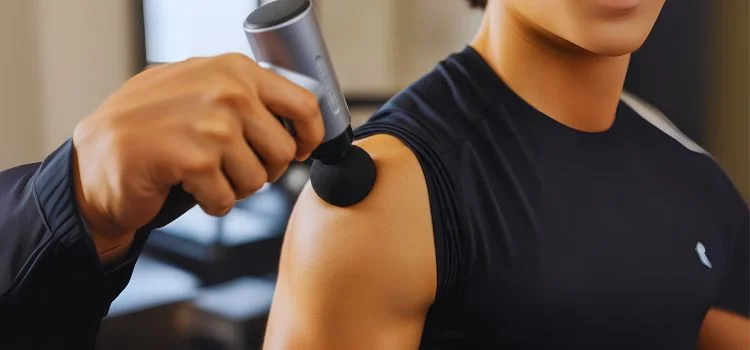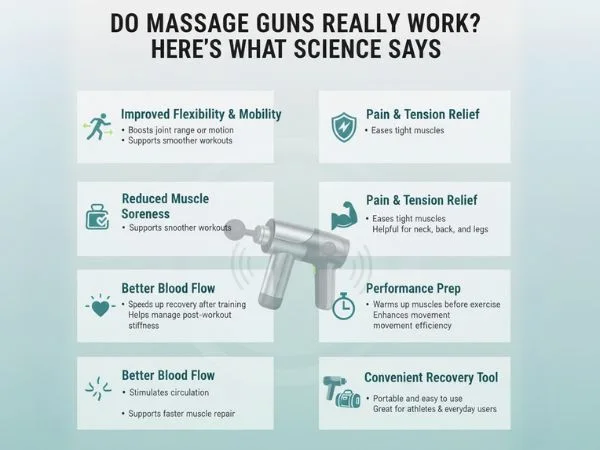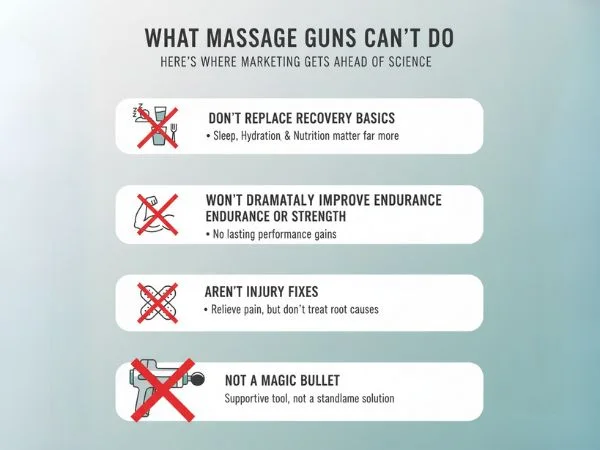If you’ve scrolled through fitness Instagram, watched athletes warming up before a game, or seen flashy ads promising “instant recovery,” you’ve likely wondered: do massage guns work like they claim?
We hear this question all the time. And the truth is massage guns can be effective, but not always in the way marketing suggests. They are not miracle devices, but when used correctly, they can be a valuable tool for performance, recovery, and pain relief.
As professionals who work with fitness, recovery, and rehabilitation, we’ve dug deep into the science and practical use of these devices. Let’s walk you through what you really need to know.

What You’ll Learn
What Is a Massage Gun & How Do They Work?
Massage guns are handheld devices that deliver percussive therapy fast, repetitive pulses applied directly to your muscles. Think of it as a deep tissue massage, but mechanized.
Here’s the basic breakdown:
- Percussion & vibration: The head of the device rapidly oscillates to send force into the muscle tissue.
- Frequency & amplitude: These determine how fast and how deep the massage gun works. High amplitude reaches deeper layers of muscle.
- Physiological response: The rapid pulses increase circulation, reduce muscle stiffness, and stimulate the nervous system to relax tension.
This is why massage guns are so popular among athletes they feel like an instant muscle reset. But let’s look at what the science actually confirms.

Benefits of Massage Guns
We always want to separate hype from evidence. Here are the proven or strongly supported benefits of massage guns.
Improved Flexibility & Range of Motion
Studies consistently show that short sessions with massage guns can improve joint mobility and flexibility. For example:
- 2023 review found measurable increases in hip flexion and ankle dorsiflexion after regular use.
- Athletes who used massage guns before workouts had better movement quality compared to those who didn’t.
This is why we recommend them as part of a warm-up, especially for lower body sessions.
Reduced Muscle Soreness (DOMS Relief)
We’ve all felt the dreaded soreness 1–2 days after training. Massage guns help by:
- Increasing blood flow to sore muscles
- Stimulating pain-relief pathways in the nervous system
- Breaking up perceived tightness in fascia
Systematic reviews show reduced delayed onset muscle soreness (DOMS) after massage gun use.
Short-Term Performance Boosts
Some research shows small improvements in explosive strength (like jumping or sprinting) immediately after using a massage gun. It likely comes from neural activation and reduced stiffness.
While this isn’t a game-changer, athletes may benefit from using massage guns during warm-ups.

What Massage Guns Can’t Do
Here’s where we see marketing get ahead of science.
- They don’t replace recovery basics: Sleep, hydration, and nutrition matter far more.
- They won’t dramatically improve endurance or strength long term. Research hasn’t shown massage guns lead to lasting performance improvements.
- They aren’t injury fixes: While they can relieve pain, they won’t treat the underlying causes of injuries.
So, while they have value, don’t expect them to be magic.
Risks & Safety: What You Should Know
Massage guns are generally safe, but only if used properly. Here are some key points we emphasize with clients.
Massage Gun on Neck: Handle With Care
We strongly advise caution here.
- The front and sides of your neck contain vital arteries (carotid and vertebral). Using a massage gun aggressively in this area can increase the risk of stroke or arterial injury.
- If you use it on the back of the neck, keep settings low and avoid pressing on the spine or bones.
Blood Clots & Circulation Risks
A common question is: can massage guns cause blood clots in legs?
- If you already have deep vein thrombosis (DVT) or are at high risk (recent surgery, clotting disorders, immobility), then yes, using a massage gun could worsen the risk.
- In healthy people, massage guns don’t typically “cause” clots. But if you notice swelling, redness, or pain in your legs, stop immediately and seek medical help.
Other Safety Concerns
- Avoid using over bones, joints, open wounds, or bruises.
- If you have osteoporosis, diabetes, or vascular issues, consult your doctor before use.
- Don’t exceed 1–2 minutes per muscle group overuse can bruise or damage tissue.
How to Use a Massage Gun Properly
Here’s our professional advice for safe, effective use.
For Legs (Quads, Hamstrings, Calves)
- Duration: 30–60 seconds per muscle group.
- Technique: Keep the gun moving slowly, avoid lingering in one spot.
- Protocol: 3 times per week works well for flexibility improvements.
For Neck
- Stick only to the back of the neck, on the muscles next to the spine.
- Use low speed and avoid bony areas.
- Never use it on the front or side of the neck.
Before vs After Workouts
- Pre-workout: Use for 30 seconds per muscle to loosen up and improve mobility.
- Post-workout: Use 1–2 minutes per muscle to ease soreness and improve recovery.
Choosing the Right Settings
- Start at the lowest speed and increase gradually.
- Use softer, round attachments for big muscles and smaller heads for targeted areas.
- Always listen to your body pain is a red flag.
Who Should Avoid Massage Guns
We recommend avoiding massage gun use (unless cleared by a healthcare professional) if you:
- Have a history of blood clots, clotting disorders, or are on blood thinners
- Are pregnant (especially abdomen and lower back)
- Have open wounds, skin infections, or recent fractures
- Have nerve damage or loss of sensation in certain areas
So, Do Massage Guns Work?
Here’s our expert verdict:
- Yes, they work for certain things. Massage guns are excellent for short-term pain relief, improving mobility, and easing muscle soreness.
- They don’t replace the fundamentals. You still need proper training, stretching, rest, and nutrition.
- They must be used safely. Especially when it comes to the neck, legs (if clot risk is present), and sensitive areas.
For most healthy people, massage guns are a useful recovery tool. They’re not a miracle cure, but in the right hands, they can make training and everyday movement feel smoother and less painful.
FAQs
What does a massage gun do?
It delivers rapid pulses to muscle tissue, improving circulation, reducing soreness, and releasing tightness.
Are massage guns good for you?
Yes, when used properly, they can be very beneficial for soreness, stiffness, and mobility.
Do massage guns actually work?
Yeah for pain relief and short-term performance. No, for miracle recovery or long-term strength gains.
How to use a massage gun on legs?
Move slowly over quads, hamstrings, calves for 30–60 seconds. Don’t press too hard. Stop if painful.
Can massage guns cause blood clots in legs?
They can worsen issues if you already have DVT or clotting risk. Otherwise, they don’t typically cause clots in healthy individuals.
References & Further Reading